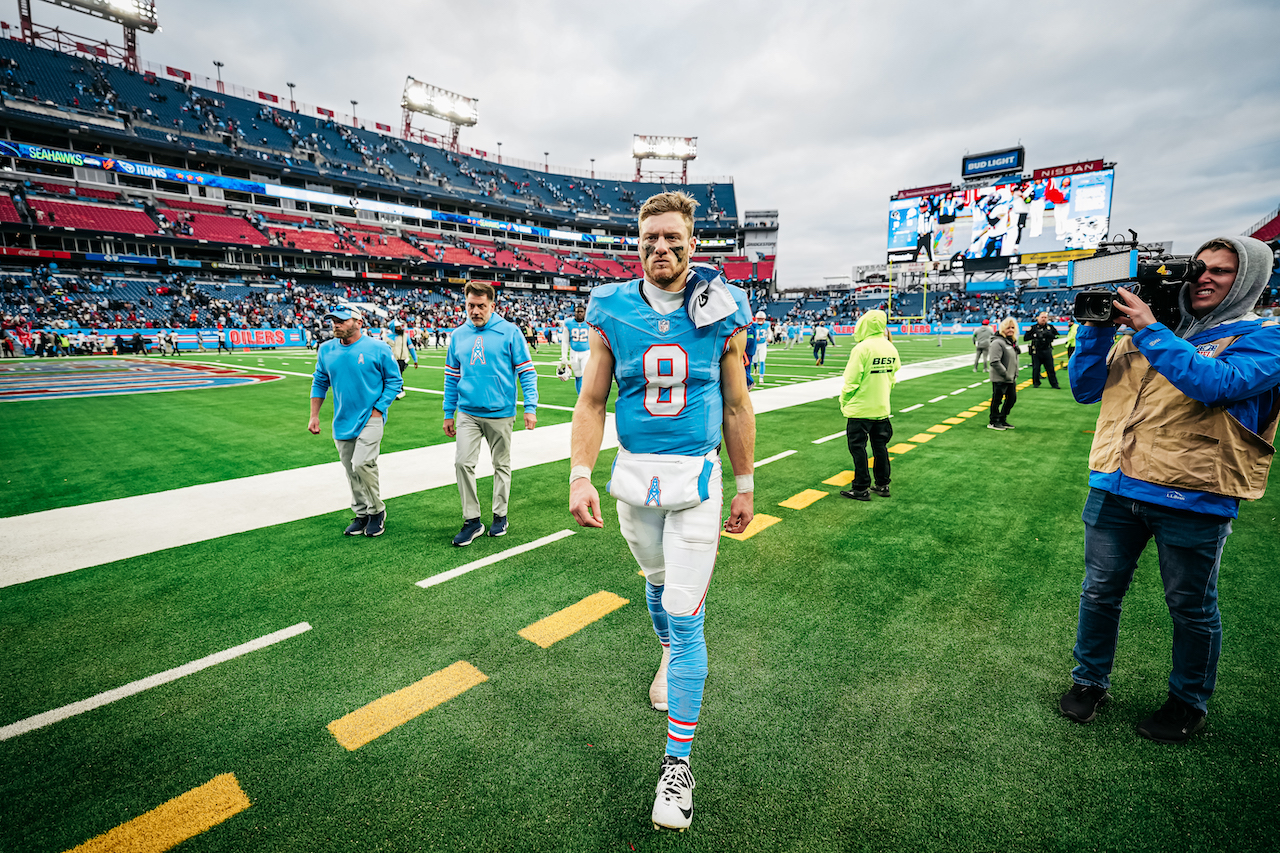By JAKE DOWNARD
Jake Downard is a law student who creates NFL and NBA content focused on analytics on Twitter as @JakeAndBall. He also works with fanspo.com. A glossary of the analytics terms he uses is at the bottom of the piece.
For a glossary of the metrics and terms used in this post, please see this earlier file.
The Tennessee Titans won the coin flip on Sunday and elected to defer. After the defense forced a three-and-out, the offense trotted onto the field coming off a 28-27 comeback win over the Miami Dolphins.
The first play was a first-down handoff to Derrick Henry that went for positive yardage. On second-and-8 later in the drive, Will Levis connected with Treylon Burks on a 37-yard-strike. Chig Okonkwo got involved, and a couple of plays later, Levis connected with Nick Westbrook-Ikhine on a free play, due to Sheldon Rankins jumping offsides, for 33 yards. The drive was then capped off by a 1-yard Levis keeper for the TD.

They moved OK for a bit on the second possession too. Throughout the first 12 minutes of the game, pass protection was great and Levis had a clean pocket to operate from. The Titans had just one negative play in the run game. They had already generated three X-plays in the passing game.
I hope you enjoyed it.
Unfortunately for the team in Luv Ya Blue uniforms, NFL games last longer than 12 minutes. Despite the tremendous start where, for a fleeting moment, it felt like the team’s offense may finally be starting to click, they reminded us of their inherent limitations, personnel disadvantages, inconsistencies, and abhorrent offensive line play. Let’s crunch the numbers.
The Titans finished the first quarter with a 0.305 EPA/play and a 0.644 Dropback EPA/Play, good for fourth (among 30 teams) in the NFL. Pair those figures with a 0.004 Rush EPA/play, good for ninth in the NFL, and you’ve got a recipe for a potent offensive attack.
EPA/play numbers encompass every aspect of an NFL offense and ultimately quantify an NFL team’s ability to generate points. While EPA/play is an excellent figure, it never tells the whole story. Success Rate is another number that quantifies an offense’s ability to consistently generate positive plays. Success Rate does not discriminate. For example, a pass for 75 yards on 1st-and-10, and a run for two yards on fourth-and-1 are both considered successful plays. Mike Vrabel and Tim Kelly have harped on staying on schedule all season. Success Rate is a great figure to quantify that.
When you take a glance at the teams above the Titans in first-quarter EPA/play Saturday and Sunday -- San Francisco, Kansas City, and Las Vegas -- their EPA/play numbers are accompanied by Success Rates of 62.5%, 72.7%, and 60.0%, respectively. The Titans, on the other hand, finished the first quarter with a Success Rate of 35.3% despite their impressive EPA numbers, which was ultimately a sign of things to come.
Here is how the Titans ranked from the 2nd Quarter until Ka’imi Fairbairn’s game-winning FG in OT in the above-referenced numbers:
- EPA/play: -0.362 (27th)
- Success Rate: 23.9% (29th)
- Dropback EPA/play: -0.327 (27th)
- Dropback Success Rate: 32.1% (27th)
- Rush EPA/play: -0.417 (24th)
- Rush Success Rate: 11.1% (28th)
As you can see, when the Success Rate numbers remain low, and the offense fails to generate X-plays, the offensive efficiency as a whole begins to regress to the mean. When the offensive line does not consistently create clean pockets for Levis to sit in or lanes for Henry and Spears to run through, things get really bad, really quickly. The lower Success Rate in the first quarter told us the writing was on the wall, and when the X-play sieve dried up, the Titans offense looked severely dehydrated.
Here is how the Titans' run game finished up on Sunday in Nashville:
- Tyjae Spears: 9 carries, 30 yards (3.3 YPC)
- Will Levis: 4 carries, 25 yards (6.3 YPC)
- Derrick Henry: 16 carries, 9 yards (0.6 YPC)
- Treylon Burks: 1 carry, 2 yards (2.0 YPC)
The longest run by a Titans’ skill position player on Sunday was the 9-yard scamper by Spears late in the first quarter. Will Levis and the passing game faced similar struggles after the rookie threw for 76 yards and went untouched on dropbacks during the first drive of the game. Despite the hot start, Levis finished with just 199 passing yards. Here is how Levis spread out his 26 targets on Sunday:
- DeAndre Hopkins: 9 targets (34.6%)
- Chris Moore: 4 targets (15.4%)
- Derrick Henry: 4 targets (15.4%)
- Treylon Burks: 3 targets (11.5%)
- Chig Okonkwo: 3 targets (11.5%)
- Nick Westbrook-Ikhine: 2 targets (7.7%)
- Tyjae Spears: 1 target (3.8%)
A large part of the Titans’ second-half struggles can be attributed to the offensive line. After allowing no sacks in the first half of the game, the offensive line gave up seven in the second half. Overall, PFF gave the unit an abysmal 49.0 RBLK grade and 37.2 PBLK grade. Here is each offensive lineman’s PBLK grade, the number of pressures, and the number of sacks they allowed:
- Jaelyn Duncan: 34.3 PBLK (8 pressures, 3 sacks allowed)
- Peter Skoronski: 52.5 PBLK (2 pressures, 1 sack allowed)
- Aaron Brewer: 49.2 PBLK (1 pressure, 0 sacks allowed)
- Daniel Brunskill: 48.6 PBLK (4 pressures, 0 sacks allowed)
- Dillon Radunz: 69.8 PBLK (1 pressure, 0 sacks allowed)
When an offensive line is pass-blocking at such a poor level, one might (correctly) assume that they would send help for the left tackle by way of a chip. How did those notable helpers perform in pass protection yesterday?
- Derrick Henry: 74.0 PBLK (0 pressures, 0 sacks allowed)
- Chig Okonkwo: 70.7 PBLK (0 pressures, 0 sacks allowed)
- Tyjae Spears: 41.0 PBLK (1 pressure, 1 sack allowed)
- Trevon Wesco: 21.1 PBLK (2 pressures, 0 sacks allowed)
- Kevin Rader: 6.1 PBLK (2 pressures, 0 sacks allowed)
You could not have drawn up a worse concoction of pass protection for Levis to face on Sunday. Poor interior protection, poor performances from the tackles, and poor help from guys chipping led to an onslaught of pressures, QB hits, and sacks, ultimately costing the Titans the game and officially eliminating them from playoff contention.
In what will certainly go down as one of the most disappointing and frustrating games of the season, the Titans got bullied. As they look ahead to next Sunday when the Seattle Seahawks come to town, they have got to find a way to be more consistent offensively, and that is going to start with protecting their franchise QB.











You are not authorised to post comments.